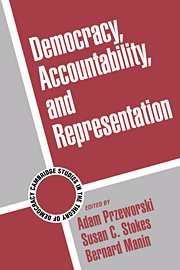11 - Situating Democratic Political Accountability
Published online by Cambridge University Press: 05 June 2012
Summary
Democracy differs from anarchism most sharply in accepting both the need for and the propriety of public and collective action and thus, arguably, in accepting the reality and legitimacy of politics. For there to be public action at all, there must be potentially binding public choice, and hence a system for making such choices and for ensuring that they do, in the appropriate circumstances, bind. There has to be a system of authority, within which, however fluid the movement of persons between the two statuses, it will at best very often be true that those who command are different from those who obey (Maistre 1965: “Study on Sovereignty,” 93). Democracy fully shares with anarchism, whether philosophical (Wolff 1970; Simmons 1993) or comparatively practical, the recognition that this vertical relation of authority is inherently hazardous. It seeks to provide, if with necessarily imperfect success, at least some degree of remedy for such hazards, short of simply abandoning the practice of public action. Unlike anarchism, it cleaves to the practice of public action because it views the state of nature, the continuous individual practical interpretation of how it is permissible to act, unmediated by any structure of institutionalized authority, as generically far more dangerous than vertical subjection to such authority (Dunn 1990: chap. 3; 1996). This is merely a vague probability calculation, and in the worst possible cases – the Holocaust – it comes out badly wrong. But in the modal case it is an eminently reasonable assessment (Hobbes 1991; Dunn 1990: chap. 3; 1995: chap. 4).
There are essentially two approaches to the task of limiting these hazards.
- Type
- Chapter
- Information
- Democracy, Accountability, and Representation , pp. 329 - 344Publisher: Cambridge University PressPrint publication year: 1999
- 24
- Cited by



